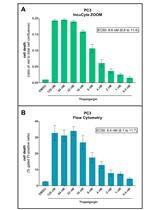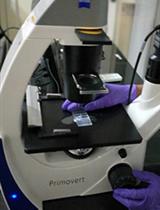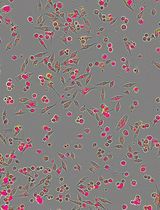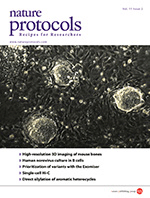- Submit a Protocol
- Receive Our Alerts
- Log in
- /
- Sign up
- My Bio Page
- Edit My Profile
- Change Password
- Log Out
- EN
- EN - English
- CN - 中文
- Protocols
- Articles and Issues
- For Authors
- About
- Become a Reviewer
- EN - English
- CN - 中文
- Home
- Protocols
- Articles and Issues
- For Authors
- About
- Become a Reviewer
Clonogenic Assay
Published: Vol 2, Iss 10, May 20, 2012 DOI: 10.21769/BioProtoc.187 Views: 100979

Protocol Collections
Comprehensive collections of detailed, peer-reviewed protocols focusing on specific topics
Related protocols

An Image-based Assay for High-throughput Analysis of Cell Proliferation and Cell Death of Adherent Cells
Paula Szalai and Nikolai Engedal
May 5, 2018 10910 Views

Evaluation of Anticancer activity of Silver Nanoparticles on the A549 Human Lung Carcinoma Cell Lines through Alamar Blue Assay
Nikita Sharma [...] Surendra Nimesh
Jan 5, 2019 14630 Views

Real-time IncuCyte® Assay for the Dynamic Assessment of Live and Dead Cells in 2D Cultures
Arlene K. Gidda [...] Sharon M. Gorski
Feb 5, 2025 2699 Views
Abstract
Clonogenic assays serve as a useful tool to test whether a given cancer therapy can reduce the clonogenic survival of tumor cells. A colony is defined as a cluster of at least 50 cells that can often only be determined microscopically. A clonogenic assay is the method of choice to determine cell reproductive death after treatment with ionizing radiation, but can also be used to determine the effectiveness of other cytotoxic agents. The following protocol has been modified from a published version (Franken et al., 2006).
Materials and Reagents
- Cell culture medium
- Phosphate buffered saline (PBS)
- Fetal bovine serum (FBS)
- Trypsin/ EDTA (Life Technologies, Invitrogen™, catalog number: 25200-056 )
- Crystal violet (Sigma-Aldrich, catalog number: C3886 )
- Methanol (Sigma-Aldrich, catalog number: 34860 )
- Glacial acetic acid (Sigma-Aldrich, catalog number: 320099 )
- Fixation solution
- Colony fixation solution (see Recipes)
- Crystal violet solution (see Recipes)
Equipment
- Cell culture petri dishes or six-well plates (Thermo Fisher Scientific, catalog number: 08-772-1B )
- Hemocytometer (Hausser Bright-Line) (Thermo Fisher Scientific, catalog number: 02-671-10 )
- Stereomicroscope (e.g., Nikon Eclipse, model: TS100 )
- Hemocytometer
- Incubator
Procedure
- Cell preparation:
- Culture the cells according to the requirement (e.g., GBM cell lines, U87, U251, SF188, etc).
- Remove medium, and then rinse cells with 10 ml PBS.
- Add 4 ml 0.25% trypsin to the cells and incubate at 37 °C for 1-5 min until the cells appear round.
- Add 10 ml medium with 10% FBS, and detach the cells by pipetting.
- Count the cells using a hemocytometer.
Note: It is critical to get a relatively accurate number for the cells.
- Prepare desired seeding concentration, and then seed cell into dishes or 6-well plates.
- Culture the cells according to the requirement (e.g., GBM cell lines, U87, U251, SF188, etc).
- Assay setup:
Cell can be plated either before or after the treatment.- Plating before treatment:
- Harvest cells and plate an appropriate number of cells per dish or per well on a 6-well plate, at least in duplicate. The number of cells for seeding should be determined by the aggressiveness of the treatment. Incubate cells for a few hours in a CO2 incubator at 37 °C and allow them to attach to the plate/dish.
- Treat the cells as necessary with chemicals (e.g., 1-100 μM), radiation (e.g., 2-10 Gy) or a combination of both.
- Incubate the cells in a CO2 incubator at 37 °C for 1-3 weeks until cells in control plates have formed colonies that are of a substantially good size (50 cells per colony is the minimum for scoring).
- Harvest cells and plate an appropriate number of cells per dish or per well on a 6-well plate, at least in duplicate. The number of cells for seeding should be determined by the aggressiveness of the treatment. Incubate cells for a few hours in a CO2 incubator at 37 °C and allow them to attach to the plate/dish.
- Plating after treatment:
- Harvest cells after treatment. Fifty or up to 50 x 104 cells can be plated. Prepare serial dilutions with different numbers of cells, should the effects of the treatments be unclear. For radiation treatment, the cells can be plated immediately after treatment or re-plated later. It is always better to keep the cells on ice before re-plating.
- Incubate the cells in a CO2 incubator at 37 °C for 1-3 weeks until cells in control plates have formed colonies with substantially good size (50 cells per colony is the minimum for scoring).
- Harvest cells after treatment. Fifty or up to 50 x 104 cells can be plated. Prepare serial dilutions with different numbers of cells, should the effects of the treatments be unclear. For radiation treatment, the cells can be plated immediately after treatment or re-plated later. It is always better to keep the cells on ice before re-plating.
- Plating before treatment:
- Fixation and staining:
- Remove medium, and then rinse cells with 10 ml PBS.
- Remove PBS and add 2-3 ml of fixation solution and leave the dishes/plates at room temperature (RT) for 5 min.
- Remove fixation solution.
- Add 0.5% crystal violet solution and incubate at RT for 2 h.
- Add 10 ml medium with 10% FBS, and detach the cells by pipetting.
- Remove crystal violet carefully and immerse the dishes/plates in tap water to rinse off crystal violet.
- Air-dry the dishes/plates on a table cloth at RT for up to a few days.
- Remove medium, and then rinse cells with 10 ml PBS.
- Data analysis:
- Count number of colonies with a stereomicroscope.
- Calculate plating efficiency (PE) and surviving fraction (SF).
PE = no. of colonies formed/ no. of cells seeded x 100%
SF = no. of colonies formed after treatment/ no. of cells seeded x PE
- Count number of colonies with a stereomicroscope.
Recipes
- Colony fixation solution
Acetic acid/methanol 1:7 (vol/vol)
- Crystal violet 0.5% solution
Acknowledgments
This protocol has been modified from a published version (Franken et al., 2006).
References
- Franken, N. A., Rodermond, H. M., Stap, J., Haveman, J. and van Bree, C. (2006). Clonogenic assay of cells in vitro. Nat Protoc 1(5): 2315-2319.
- Mueller, S., Yang, X., Sottero, T. L., Gragg, A., Prasad, G., Polley, M. Y., Weiss, W. A., Matthay, K. K., Davidoff, A. M., DuBois, S. G. and Haas-Kogan, D. A. (2011). Cooperation of the HDAC inhibitor vorinostat and radiation in metastatic neuroblastoma: efficacy and underlying mechanisms. Cancer Lett 306(2): 223-229.
- Prasad, G., Sottero, T., Yang, X., Mueller, S., James, C. D., Weiss, W. A., Polley, M. Y., Ozawa, T., Berger, M. S., Aftab, D. T., Prados, M. D. and Haas-Kogan, D. A. (2011). Inhibition of PI3K/mTOR pathways in glioblastoma and implications for combination therapy with temozolomide. Neuro Oncol 13(4): 384-392.
Article Information
Copyright
© 2012 The Authors; exclusive licensee Bio-protocol LLC.
How to cite
Yang, X. (2012). Clonogenic Assay. Bio-protocol 2(10): e187. DOI: 10.21769/BioProtoc.187.
Category
Cancer Biology > Cell death > Cell biology assays > Cell viability
Cancer Biology > General technique > Drug discovery and analysis > Chemoresistance
Cell Biology > Cell viability > Cell death
Do you have any questions about this protocol?
Post your question to gather feedback from the community. We will also invite the authors of this article to respond.
Share
Bluesky
X
Copy link









